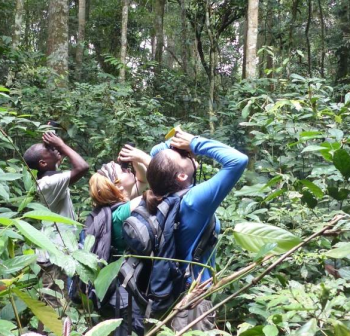
TRI recently sat down with 2018 TRI Fellow, and Yale F&ES doctoral student, Megan Sullivan to learn more about her research in Gabon.
1. Where did you go for your fellowship?
I went to Gabon to study seedling regeneration in a logging concession. I compared logged areas to un-logged areas to see how forest composition changes in response to selective logging.
2. Why did you go to Gabon?
I worked at a research station in Gabon in 2015 and I became fascinated by the forests and the country. Gabon has the most forest in West and Central Africa and there is still a lot of wildlife. In other regions of West and Central Africa, agricultural development has removed more forest, and many animal and plant species have disappeared. Gabon is a unique landscape because it’s a haven of intact forest. However, 60% of the forested area of the country is legally rented to companies that are either currently logging or will begin logging in the future. It’s important to collect baseline data before we start seeing broad-scale changes to the ecosystem.
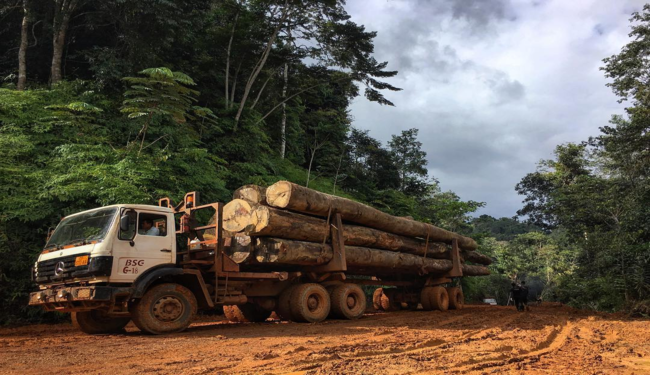
Figure 1. Logging truck leaving a Gabonese logging concession.
3. What problem were you investigating?
Selective logging is designed to limit impact because younger trees are left to replace adult trees that are removed. The forest should remain intact and ecologically viable if loggers follow those rules. Even though the limitations of selective logging are relatively well understood, we don’t know how selective logging affects the forest as a whole. I am conducting community-level surveys of logged and un-logged areas. These surveys look at factors such as species composition and diversity, as well as plant characteristics like wood density, fruit type, and seed size. I will compare which factors change, and how, to understand how the forest looks and behaves ecologically after logging. Species diversity and composition data give us information about what kinds of trees become more or less common in forests after logging. Plant characteristic data can tell us how a logged forest may function differently. For example, changes to seed and fruit size can tell us how food availability for animals may change after logging. Also, changes to wood density can inform carbon storage in logged forests
4. Why does this question matter to you, and to the people you work with?
There are Forest Stewardship Council (FSC) certified concessions in Gabon and a lot of the research is happening in them. However, a lot of small- to medium-sized companies cannot pursue FSC certification because of the up-front cost. Thus, many concessions are not FSC certified. I am interested in what is happening in these non-FSC areas post-logging.
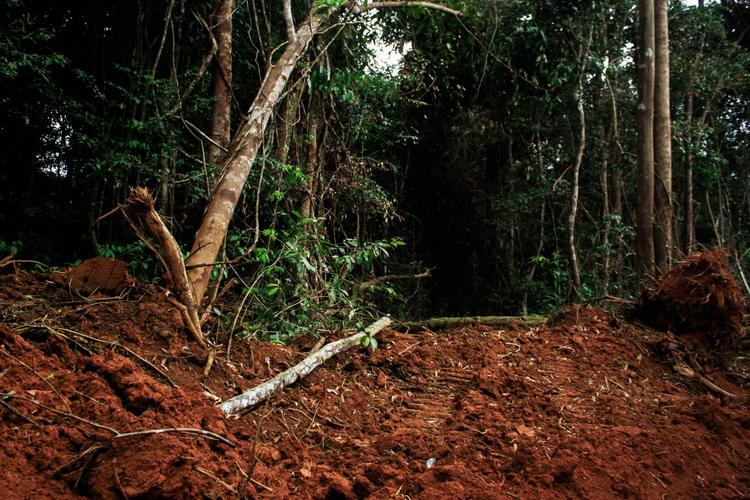
Figure 2. Forest entrance with skid trail, where logs are pulled out using meavy machinery.
5. What are the critical challenges facing your research site and the communities that are involved?
There are two main issues: the average citizen does not support the environmental movement, and there are deep divisions in the logging community. On the first topic, the average citizen in Gabon doesn’t see a lot of benefit from the environmental movement, though many people care very deeply about their forests and animals. There are few jobs in rural areas and so people rely on small farms to feed their families and villages. These farms are constantly raided by elephants, who eat most of the crops and create food insecurity for people. Many people expressed frustration about the lack of a coordinated response to elephant raiding. Also, people rely on subsistence hunting, which is often limited to certain species and in certain areas. Moreover, people are not seeing jobs and alternative options to support their families. It’s hard to accept restrictions on how you are allowed to feed your family, when you don't receive help or benefits from those same restrictions. Local people see foreigners buy up logging permits and start large plantations or mines. Locals perceive that foreigners are allowed to use the forest and natural resources in ways that the Gabonese citizen is not. Sometimes, these companies provide jobs, but often they bring workers from outside Gabon. They don’t think that Gabonese can be trained for skilled positions. Thus, Gabonese citizens are limited to lower-skilled, higher-risk, and lower-paying jobs.
The second challenge is that the logging community includes different groups: including large, multi-national corporations that are FSC-certified and invest in research and community outreach; foreign corporations that are not certified and ignore local communities in favor of bringing in foreign employees; and smaller Gabonese-owned companies that often have much less access to the training and equipment that foreign companies have. Because logging companies are so different and have different amounts of capital, access to information, and goals, it can be extremely difficult to get everyone to come to the table and discuss logging practices – let alone have everyone agree to a coordinated plan or set of rules. This disjuncture means that the effects of logging can and will vary widely—both ecologically and socially—depending on what practice each company puts in place.
6. Why do you love it?
Before this, I had never worked in a forest without a research station. It’s so different—when walking through the forest, we make our own trails… everything we do is new. And even though some days are filled with looking at tree tags all day and measuring tree diameters until your eyes cross, we’ve seen chimps, mandrills, elephants, and leopards. A lot of the time, logging an area necessarily means that hunting is increased because of increased road access deep into the forest. However, this concession is less accessible to hunters because it is bounded by a river that we need a ferry or boat to cross. So, it is protected from an influx of unwanted hunters into the area. It’s an exciting opportunity to be able to pull apart these two human disturbance pressures that are usually so heavily entwined. The disturbed forest areas often have light green vegetative regrowth that animals love to eat, and the old skid trails and logging gaps make new passageways through the forests that animals will follow and use as trails. We have seen a lot of animals in the recently logged areas—and that is a very promising sign.
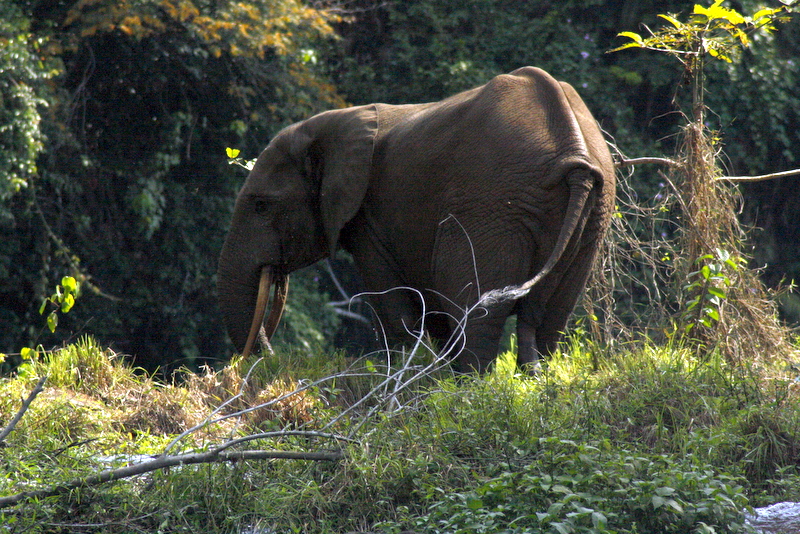
Figure 3. Forest elephant near a river in Gabon.
7. What do you think is needed to understand or improve the situation?
I think we need to address disparities that lead to certain companies getting certification while others cannot. Certainly, there are companies that would not choose to become certified even if they had the capital and were able to access the tools and information—but I am mostly thinking about smaller, national companies that simply don’t have the capital up front to invest in certification or the connections to find the information about how to do it. Certification is profit-driven and it prevents better environmental measures from being adopted widely. Currently, accessibility gaps are creating market segmentation that actually prevent movement towards certifications—which is problematic. I do believe that Gabon is moving to address this situation—last year the President announced that all forest concessions in Gabon will have to be FSC certified by 2022. I am excited to see what develops from this announcement and am looking forward to seeing a plan come into place to help companies achieve certification.
8. What challenges did you experience in your research?
The first challenge is that information about how to do this kind of research is very decentralized. Information about getting permits is on the web, but it’s hard to apply remotely. I wanted to work in logging concessions, but I needed to find a concession that was open to me setting up my plots. Then I needed to figure out how to get a permit and meet an advisor to supervise and mentor on Gabon-specific elements of research. I am very lucky that my contacts were willing to meet with me and take the time to give me advice. My contacts at the National Parks Agency, Institute of Tropical Ecology, and the National Herbarium of Gabon were absolutely essential to my work. I would not have gotten anywhere without them. Additionally, the folks at the logging company that I work at have been an amazing help. I was able to go out for a few days with one of the teams that inventories the forest before cutting. I learned so much from them, many of whom have been working with the company for a decade and have so much knowledge. I am so grateful to everyone I have crossed paths with because of this project.
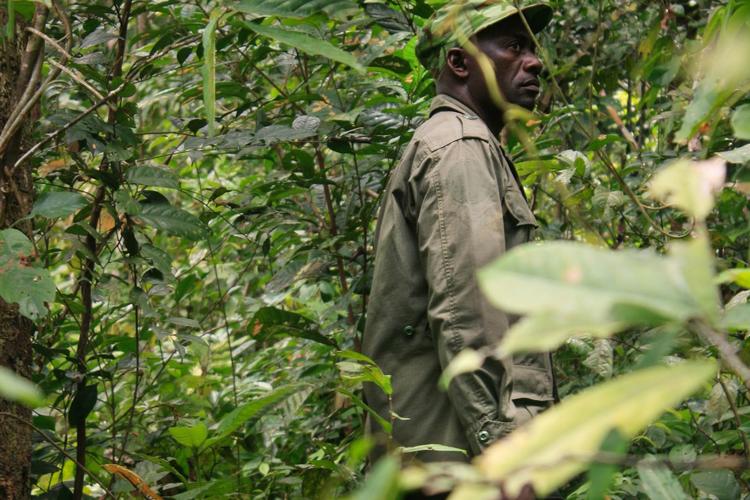
Figure 4. ANPN Ecoguard Toussaint, a member of the field team that has supported Megan's project since 2017.
The second challenge is the cultural differences that exist when working abroad. I’ve been in Gabon on-and-off for five years, and I have learned so much and adapted. I prioritized staying in Gabon as long as possible—I’ve been there for about 2.5 years, and I’m currently in the 4th year of my PhD. I was immersed in the culture. I was able to listen, drink beers with folks, and hear their stories about elephant crop raiding over and over again. Listening to people’s frustrations or ideas about what they want from the government or from the environmental movement is not directly part of my research. However, it’s critical to understand how people experience forests and wildlife, and ultimately how this experience shapes their perceptions of conservation and forest management.
The third challenge was the physically taxing nature of working in remote forests. I had to explain why random plot selection was important, especially when my team wanted me to select plots near the road that were easier to access. Cultural hierarchy is also very important in Gabon. Old men are more respected than young women. It was challenging to be a younger, foreign woman trying to convince a team of older Gabonese men to walk up a long, steep hill just to find the spot that my R code picked up on the map. Despite that, we were able to navigate through the challenging bits.
There were some memorable days where we would have chimps above us in the plots, the field team was hitting our stride, and everyone was joking and laughing, or when we were sharing different kinds of scary stories or folk tales around the fire. I was also able to work with two master’s students from the School of Water and Forests in Gabon. It was an amazing experience, they were so excited to review ecology topics, to learn methods, and to get out in the field. They were excited to experience everything that I thought of—and it was amazing to have that infusion of energy into the work.
9. How do you think your research may be used?
I hope that my research can help inform the process of concession certification in Gabon. I have been working with national park managers and forest managers. I hope to present my findings to the National Agency for National Parks and other government ministries so that they can use the data to inform the certification process.
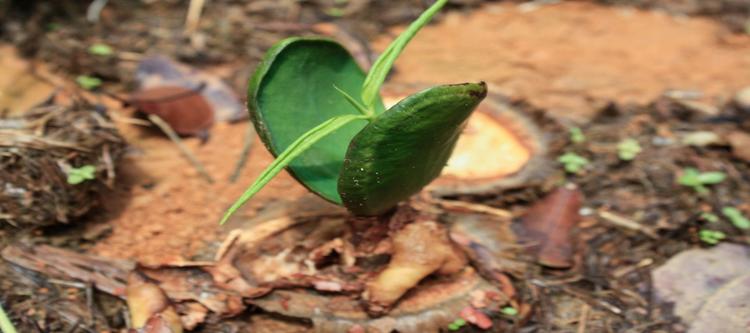
Figure 5. An andok (Irvinga gabonensis) seedling sprouting in a pile of elephant dung on a closed-off logging road in Gabon.
10. Is there anything else you want to tell us?
Overall, I really loved my fieldwork and there are many possible positive outcomes. I hope to see positive changes occur. Logging is at a complicated intersection of politics, class struggles, environmentalism, and culture—these are tough issues, but there is a chance to make big changes that could make big improvements in the future.
In addition to TRI, I recieved generous support from the Macmillan Center & its Council on African Studies, the Linnean Society of London, the Garden Club of America, and the New York Botanical Garden. Many thanks to IRET/CENAREST in Gabon for help in obtaining permits and to collaborators at the National Parks Agency (ANPN) and the National Herbarium of Gabon for indispensable advice and logistic support.
You can learn more about Megan’s work here
https://meganksullivan.weebly.com/
https://tri.yale.edu/people/megan-sullivan.